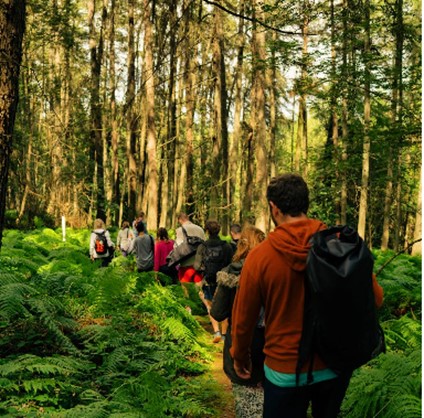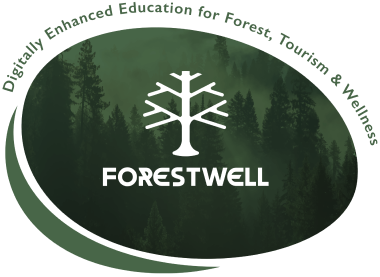Topic Progress..
Designing storytelling for a forest product or service from a regenerative perspective involves creating a compelling narrative that not only promotes your offering but also communicates its positive impact on the environment, communities, and the broader ecosystem. The content in this topic will help you produce storytelling by utilising available services and businesses for the forest environment. In the end, there is material to fill in to support the development work, which you can use creatively for your own needs.

You can see the content of this module compiled in the image above and the same content is repeated in the development task.
Check out one of the ForestWell Case studies: The Healing Forest, Ireland
The Healing Forest was founded by Luke and Nicoline to support their clients while they navigate their way through life.
They have written one important sentence which you can read below to remind us that when meeting people, an important skill is to sensitively sense the atmosphere and to understand that not everyone is willing to experience or share new things and for some persons, it takes more time.

During the walk, there will be some invitations from our guides to connect with nature and then come back to share with the group. The space held is safe and non-judgmental so there is no pressure to do anything at all, including sharing. This is only an invitation and is fully respected if not undertaken. The walk concludes with a gratitude or a tea ceremony and a chat to ease you back into your everyday tasks.
The diversity of nature and changes in the environment where you operate is good content for a story-based service. You can tell which species are non-native species, why they need to be removed and include the eradication of non-native species in the service. Note this example also in the contents of the 7th heading: Educate and Raise Awareness.
Emotional connections are made by awakening different senses and reminding the participants of memorable memories. A certain smell can bring to mind childhood or a certain taste can awaken a completely new feeling. Food brings people together and talking at the same table lowers the threshold for conversation. If possible, include a meal in the service that is part of the story. Tell the story of the food and bring the farmers and the kitchen staff into your story.
Have a look at the Slovenian Case Study number nine: Eko Tourist Farm Urska or enter to the company´s website Kmetija Urska.
You can read more about the Love Forest Finland initiative from the website: Love Forest Finland
Use Storytelling comprehensively in marketing as well as building and strengthening the brand. Take advantage of the tips from the article below: Storytelling for Sustainable Destination: Solimar International
Clear arguments can be a good way to get attention, and a long-lasting story can start from something unique. Such an example is the company called Móðir jörð Vallanesi – Mother Earth Vallanes in Iceland. In addition to all the other good things, they hold the following “record”: Asparshúsið is the first house in Iceland that is built entirely from Icelandic timber and that timber was all grown in Vallanes.
Please, read more about this interesting company here: Case Study Iceland, Móðir jörð Vallanesi – Mother Earth Vallanes, Iceland
Storytelling for your forest product or service is a powerful tool for connecting with your audience, inspiring action, and building a community of advocates for sustainability and regeneration. By weaving a compelling narrative that highlights the positive impact of your offering, you can engage and mobilize people to support your regenerative mission.
